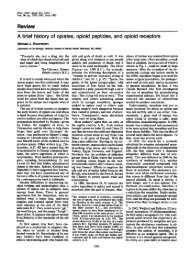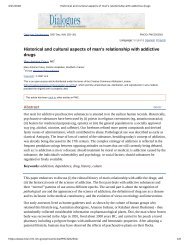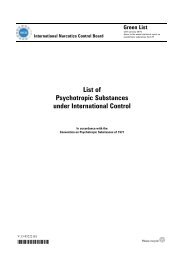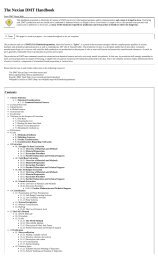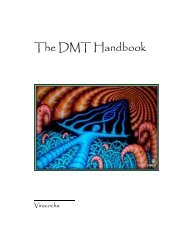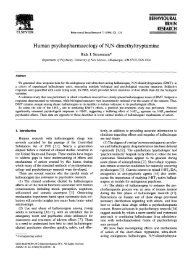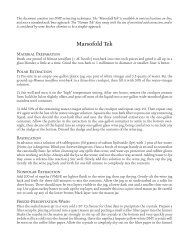The Nexian DMT Handbook - DMT-Nexus Wiki
The Nexian DMT Handbook - DMT-Nexus Wiki
The Nexian DMT Handbook - DMT-Nexus Wiki
You also want an ePaper? Increase the reach of your titles
YUMPU automatically turns print PDFs into web optimized ePapers that Google loves.
Purification<br />
<strong>The</strong> purification of <strong>DMT</strong> product has several purposes and is accomplished by several different methods, but all of them essentially involve the<br />
washing of product in some way or another. Purification either involves the isolation of product from unwanted impurities from the plant source or<br />
from the process of extraction, or it involves the isolation of product from active impurities which may or may not be collected after isolation.<br />
Recrystallization<br />
<strong>The</strong> general purpose of recrystallization is to crystallize the product in a fresh solvent after it has already been isolated from the extraction solvent,<br />
likely containing a considerable amount of impurities. In this technique, an impure solid compound is dissolved in a solvent and then allowed to<br />
slowly crystallize out as the solution cools. Often this process results in more well-formed crystals with less discoloration. <strong>The</strong> advantage of this<br />
method of purification is that the solvent choice for recrystallization may be different and more suitable than that chosen for extraction. Crystallization of a solid relies on slow,<br />
selective formation of the crystal lattice and is quite different from precipitation. In freeze precipitation, there is a rapid formation of a solid from a solution that causes impurities to<br />
be trapped within the solid's crystal framework. For this reason, extractions that rely on precipitation or evaporation to produce a solid product always include a final recrystallization<br />
step to give the pure compound.<br />
<strong>The</strong> process of recrystallization relies on the property that for most compounds, as the temperature of a solvent increases, the solubility of the compound in that solvent also<br />
increases. For example, much more sugar can be dissolved in very hot water (just below boiling) than in water at room temperature. Inversely, if a hot saturated solution of sugar and<br />
water is allowed to cool, sugar will begin to crystallize out of solution as solubility decreases. Recrystallization will give your product a more sharply defined, uniform melting point<br />
and in the case of <strong>DMT</strong> allow for hard non-waxy crystals.<br />
Removing Inactive Impurities via Recrystallization<br />
Materials Required<br />
Source Material:<br />
1. Find a suitable solvent for the recrystallization;<br />
2. Dissolve the impure solid in a minimum volume of hot solvent;<br />
3. Remove any insoluble impurities by filtration;<br />
4. Slowly cool the hot solution to crystallize the desired compound from the solution.<br />
Freebase <strong>DMT</strong><br />
Solvents:<br />
Heptane<br />
Reagents/Desiccants:<br />
Equipment:<br />
Activated Charcoal (eg. Norit)<br />
Filter papers, Beakers, Waterbath, Pipette<br />
Finding a suitable solvent<br />
<strong>The</strong> first consideration in purifying a solid by recrystallization is to find a suitable solvent. A good recrystallization solvent should fit the following criteria:<br />
1. <strong>The</strong> compound should be very soluble at the boiling point of the solvent and only sparingly soluble in the solvent at room temperature.<br />
2. <strong>The</strong> unwanted impurities should be insoluble in the hot solvent.<br />
A good recrystallization solvent for <strong>DMT</strong> is heptane. <strong>DMT</strong> is not very soluble in it at room temperature but quite soluble as we add heat. Most common spice impurities, however,<br />
are not very soluble in it at all and can thus be separated via simple decanting.<br />
Dissolve solid into hot solvent<br />
Prepare a waterbath and heat the <strong>DMT</strong> and the heptane in their own beakers until the <strong>DMT</strong> begins to melt. Add heated solvent dropwise into the beaker containing the extract. <strong>The</strong><br />
heptane will go cloudy almost immediately and take on a yellow color as the <strong>DMT</strong> goes into solution. Keep adding heated solvent until further addition or agitation causes no more<br />
<strong>DMT</strong> to dissolve.<br />
Your beaker should now contain yellowish-tinged heptane with an orange-brown blob of oil and undissolved solids at the bottom of the vessel. Carefully decant the solution into<br />
another beaker, careful to leave the impurities behind. Repeat dropwise addition of heated solvent and decantation to ensure no <strong>DMT</strong> is left behind.<br />
Decolorize with carbon<br />
Now that we have dealt with insoluble impurities, our solution is see-through but tinged yellow. This discoloration is due to the presence of high-molecular-weight reaction byproducts<br />
which may have been formed during the extraction process. A simple wash with activated carbon will get rid of decolorizing compounds. (Activated carbon is extremely<br />
efficient at absorbing impurities due to its large surface area.)<br />
1. Add excess solvent and activated carbon, and boil the solution for a few minutes. <strong>The</strong> colored impurities will adsorb onto the surface of activated charcoal.<br />
2. Remove the charcoal with absorbed impurities by filtration. Your solvent should now be almost clear. If the yellow color persists, repeat the charcoal wash carefully.<br />
Note: Very little activated carbon is needed to remove the colored impurities from a solution. You must be careful in your use of decolorizing carbon: if too much is used, it<br />
can adsorb the desired compound from the solution as well as the colored impurities.<br />
Crystallization<br />
After the solution has been filtered cover the flask containing the hot filtrate and set it aside undisturbed to cool slowly to room temperature. As the solution cools, the solubility of<br />
the dissolved compound will decrease and the solid will begin to crystallize from the solution. Once the solution reaches room temperature, move it into the refridgerator, and finally<br />
into the freezer to freeze precipitate most of the <strong>DMT</strong>.<br />
<strong>The</strong> slower your solution cools, the cleaner and larger your crystals will be.<br />
Further Reading<br />
How to Crystallize Organic Compounds - <strong>Wiki</strong>How (http://www.wikihow.com/Crystallize-Organic-Compounds)<br />
Recrystallization Technique - Rhodium (http://loinen.i2p.to/rhodium/chemistry/equipment/recrystallization.html)




